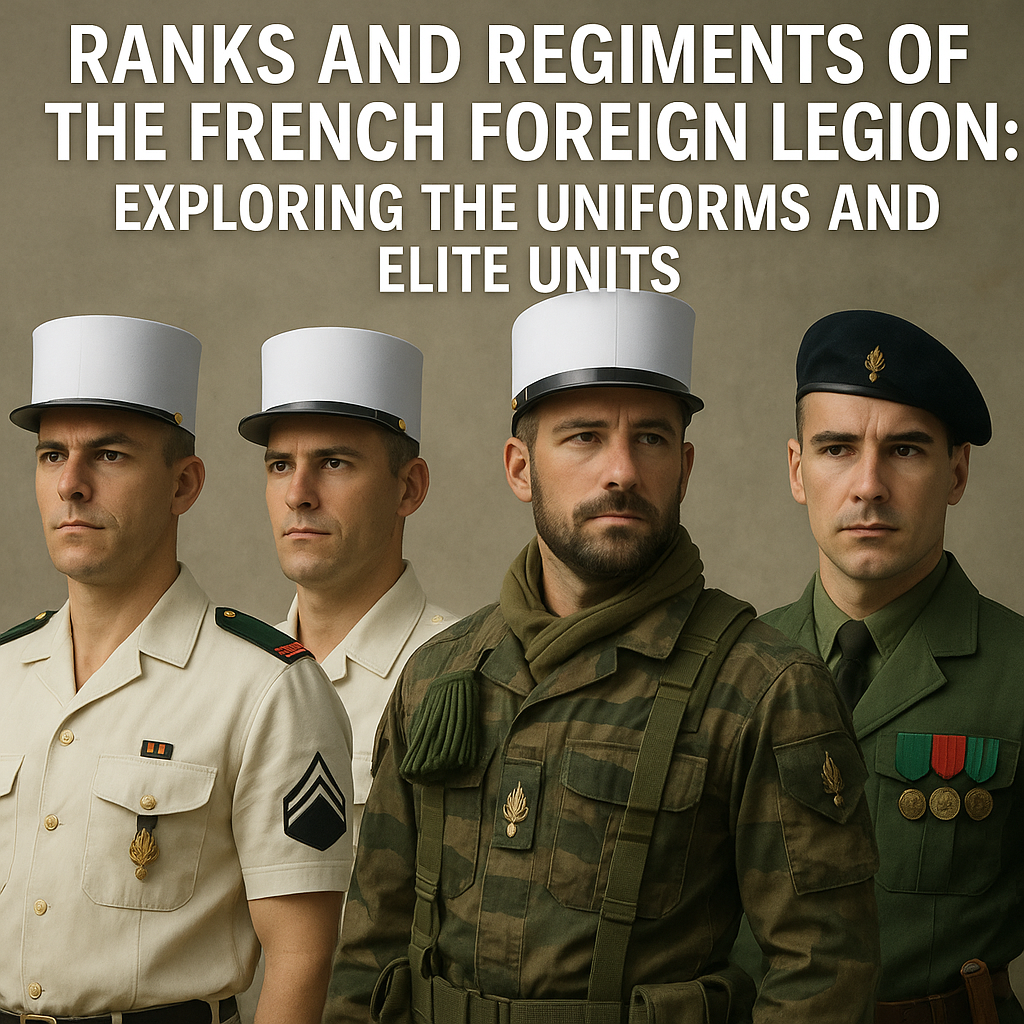
Ranks and Regiments of the French Foreign Legion: Exploring the Uniforms and Elite Units
Published on May 14, 2025
Ranks and Regiments of the French Foreign Legion: A Deep Dive into Tradition and Elite Units
The French Foreign Legion, or Légion Étrangère, has captivated military enthusiasts and history buffs for decades. Known for its strict discipline, diverse ranks, and legendary regiments, this elite branch of the French Army combines heritage with cutting-edge combat readiness. From the timeless legion étrangère uniform to the gruelling standards of the French Foreign Legion Mountain Commando Group, there’s much to explore.
In this article, we’ll uncover the Legion’s rank structure, its regimental composition, and how its uniforms reflect tradition and toughness. We’ll also touch on how to join this elite force through the French Legion recruitment process.
Understanding the Hierarchy: Ranks in the French Foreign Legion
The Legion follows the traditional French military rank structure but adds its character forged through hardship and pride. Here's a breakdown of the main ranks:
Enlisted Ranks (Militaires du Rang)
- Légionnaire (Private) – The entry-level soldier.
- Caporal (Corporal) – Usually earned after about a year of service.
- Caporal-chef (Senior Corporal) – Requires experience and excellent performance.
Non-Commissioned Officers (Sous-Officiers)
- Sergent (Sergeant) – Leads squads and platoons in training and combat.
- Sergent-chef (Staff Sergeant) – Takes on tactical responsibilities and mentoring.
- Adjudant / Adjudant-chef – High-ranking NCOs with vast operational experience.
- Major – The top NCO rank, often involved in command support roles.
Officers (Officers)
- Lieutenant / Capitaine – Lead companies and direct missions.
- Commandant / Lieutenant-colonel – Tactical unit leadership.
- Colonel / Général – Strategic roles with oversight of regiments or entire operational zones.
Each of these ranks wears distinctive insignia, proudly displayed on the legion étrangère uniform, which represents loyalty, honour, and tradition.
The Regiments of the French Foreign Legion
The Legion is not just one unit; it consists of several regiments with unique roles, operational environments, and histories. Each regiment has its traditions and specialities, which together form the backbone of this elite force.
Key Regiments:
- 1er Régiment Étranger (1er RE): The oldest and administrative backbone of the Legion.
- 2e Régiment Étranger de Parachutistes (2e REP): The airborne regiment—renowned for rapid deployment and elite combat ability.
- 1er Régiment Étranger de Cavalerie (1er REC): Combines traditional cavalry and modern armoured operations.
- 2e Régiment Étranger d’Infanterie (2e REI): Known for heavy infantry roles, especially in overseas territories.
Spotlight: French Foreign Legion Mountain Commando Group
One of the most respected and feared units within the Legion is the Groupe de Commandos Montagne (GCM), also known as the French Foreign Legion Mountain Commando Group.
What Makes the GCM Special?
- Extreme Training: Operates in high-altitude, alpine, and arctic environments.
- Elite Selection: Only the most physically and mentally capable legionnaires are chosen.
- Specialized Roles: Includes reconnaissance, survival, demolition, and sniper training.
The GCM is a shining example of what the French Foreign Legion stands for—determination, excellence, and adaptability.
Legion Étrangère Uniform: Style, Symbolism, and Function
The legion étrangère uniform is iconic and instantly recognizable worldwide. From the white képiképi blanc to the green epaulettes, each detail carries meaning:
Key Features:
- KépiKépi Blanc (White Cap): Symbol of earned identity, awarded after basic training.
- Green Epaulettes: Signifies belonging to the Legion, often used during ceremonial events.
- Sashes and Badges: Reflect rank, experience, and sometimes deployments.
Functional adaptations are also made for combat uniforms, especially for regiments like the GCM, which operate in extreme environments.
French Legion Recruitment: The Journey Begins
Interested in joining this elite force? The French Legion recruitment process is rigorous, and rightly so. Applicants from around the world are welcome, and no experience is necessary, but mental toughness is a must.
Steps to Join:
- Present Yourself at a Legion Post: No online applications. You must physically go to a recruitment centre in France.
- Medical & Psychological Evaluation
- Physical Fitness Tests: Pull-ups, running, and more.
- Background Check: The Legion accepts people with complex pasts but requires honesty.
- Selection & Basic Training: If chosen, recruits undergo a brutal 4-month training in Castelnaudary.
The journey is tough, but the reward is a place in one of the most respected military organizations in the world.
Conclusion: The Brotherhood of the Foreign Legion
The French Foreign Legion is not just a military unit—it’s a legacy of honour, discipline, and transformation. From the raw recruit donning his first legion étrangère uniform to the elite operators of the Mountain Commando Group, the Legion is built on a unique bond that transcends borders, pasts, and nationalities.
Whether you're a historian, collector, or aspiring legionnaire, understanding the ranks and regiments offers a deeper appreciation of what it takes to earn the right to wear the white képiképi and serve in the world’s most iconic foreign military force.
